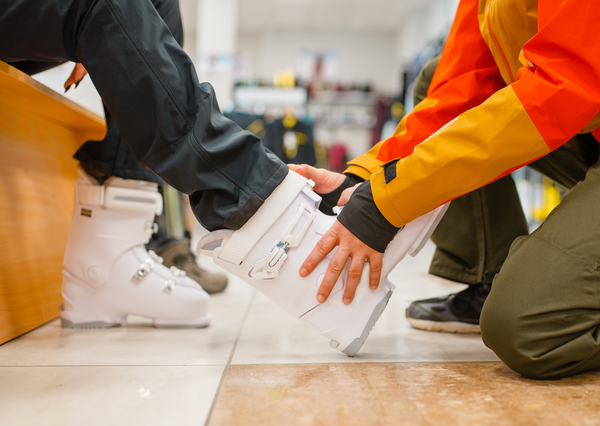
Do Your Backcountry Ski Boots Fit You Properly?
Schedule an appointment with a Master Boot Fitter at our shop in Ballard to get your performance and comfort dialed.
This article covers reasons why your ski boots might not be fitting well and the steps you can take to improve both your fit and your performance.
This video is basically a condensed version of the below article but served up by one of our very own master bootfitters, Jerry.
To find out if your backcountry ski boots fit properly, the first question we always ask is, “do your feet hurt when you ski?”
This is because there are three important considerations when fitting an alpine touring boot: The first is comfort, the second is also comfort, and the third is performance. Once more, for the people in the back…
Considerations for finding properly fitting ski boots:
- Comfort
- Comfort
- Performance - performance largely has to do with the style of boot you pick (Read the article: What Style Of Ski Boot Is Right For You)
There is a common misconception that ski boots should be uncomfortable. Let me set the record straight: YOUR SKI BOOTS SHOULD BE COMFORTABLE. That means no numbness, no blisters, and no cramping. Now, a lot of skiers will put up with a bit of discomfort in exchange for performance when skiing downhill. If you want the great performance that comes from being completely locked down in a stiff boot, it’s never going to be as cozy as your Crocs. However, when you’re in walk mode and climbing up a mountain, your boots should be very comfortable. They have to be, because you're in them all day. You're not going to the lodge to take your boots off and let your feet relax.
This article will walk through the three components of a boot that will help you reach comfort and performance goals.
- The shell of the boot
- The liner of the boot
- The insoles or footbeds of the boot
To get the ideal comfort + comfort + performance formula, we look at a few different factors. First, your boot should be snug enough that your heel stays locked down (i.e. no blisters from your foot moving around plus the ability to engage your skis when you turn). Next, you’ll want enough room in the right places to avoid unnecessary pressure (i.e. no numbness or tingling from your circulation being cut off or toes being crushed). Finally, you need a footbed that supports your unique arch (i.e. no muscle cramping in your lower leg or feet from a collapsing arch).
When you try on the boot, it should feel like it is giving you a nice, firm handshake. You should feel good, firm pressure all the way around your foot with the possible exception of the toe area if it is a new boot and the liner hasn’t been heat molded yet. Until the liner is heat molded to your foot, the toe area of a correctly sized boot will feel tight. Most people buying ski boots without the aid of a professional bootfitter tend to buy boots that are too big for them, leading to blisters from the uphill travel and poor performance when skiing downhill skiing. This is why it is so important to have a professional size a ski boot for you.
Once you have decided on the style of Alpine Touring ski boot you want (Ultralight, All-Around, or Performance) you will pick the boot within that category that fits closest to your foot.
Picking the correct shell size for a ski boot
When we do a boot fit, we check for the correct shell size by removing the liner from the boot and having you step inside. We will then have you slide your foot forward to touch your toes to the front of the boot so we can measure the amount of space behind your heel. What we’re looking for in a correct shell fit is about two fingers of space or three-quarters of an inch.
If you are unable to get an appointment with a bootfitter, you can check your own foot for a recommended shell size, called a Mondopoint size . A simple way of doing this is to place a piece of paper on the floor against a wall, step onto the paper with your heel against the wall and all of your weight pressing down on the foot you want to measure. Mark the end of your big toe, and measure (in centimeters) from the heel edge of the paper to the mark. That number (in centimeters) is your Mondopoint size. It’s important to measure both feet and use the length of the smaller foot. A master bootfitter can always punch out a slightly too-small boot, but it is a much bigger ask to shrink a boot. We’ll touch on shell modifications (like punches) later on.
Ski boots generally come in two sizes for one shell size (hence Mondopoint). For example, where a running shoe will have separate shoes for size 26 and 26.5, a 26 size ski boot is the same shell and liner as a 26.5 ski boot. The difference is likely that the footbed in the half size up is a little thicker to accommodate the difference. This Mondopoint system adds to the confusion of picking a shell size, so it doesn’t have to be us, but truely the single biggest favor you can do yourself is getting a pro to choose your shell size.
Do I need a custom footbed for my ski boots?
The short answer is yes, yes you do.
Almost everyone experiences increased comfort and performance from a custom footbed and most ski shops (like ours) have the ability to mold a footbed specially for you. A footbed will help fill any extra volume inside a boot as well as give you the comfort and support for long uphill tours and ultra-shreddy downhill descents.
Some wonderful things a custom footbed can do:
- Offer extra stability to an over-flexible foot/ankle that collapses easily
- Keep a foot that stretches out under the pressure of skiing from jamming up against the front of the boot
- Help a rigid foot “share the load” with the arch instead of putting all your body weight solely on your heel and ball of your foot.
Heat-moldable liners are the new best thing
Almost all ski boots these days, and definitely Alpine Touring boots, have heat-moldable liners. Heat moldable liners are the easiest way to get a great fit and achieve your comfort goals. To get this liner fitted, we heat it up in one of our Thermo ovens for about five minutes, put it in your shells, and have you put on the boots. As the liner cools, it will conform to the shape of your foot..
As we mentioned earlier, the toes should no longer feel tight after this heat molding process. This is because we will have put padding on your toes before you put your feet into the heated up liners. That padding pushes out the toe area of the boot, giving you the room you want for all-day comfort while you're touring. How do you know if you currently have enough room in the toe of your boots? You should be able to wiggle your toes without feeling like they're pressed up against the front of the boot. The toe area is really the only place that should have this wiggle room. The rest of the fit, from the ball of the foot back, should be snug with firm support and a fully locked down heel.
Shell modifications
After you have worked with a bootfitter to find the perfect make and model of boot to match your foot shape and performance requirements, and after you have had your liners & footbeds molded to your feet, in some (rare) cases a shell modification may be necessary. This can be achieved by having a professional bootfitter carefully heat up the boot shell to reshape certain areas of the boot, or by grinding and removing material from the inside of the shell.
Getting your boots fitted
At Ascent Outdoors, our goal is for all of our customers to be able to ski well and comfortably in their ski boots. When you buy your boots in-store from one of our bootfitters, you are also purchasing our “boot fit guarantee.” That means you’ll receive free liner molds and shell work as needed for the entirety of the current ski season.
Boot fitting is a free service for all boots purchased at Ascent Outdoors. But we offer paid bootfitting no matter where you got your boots, and we’ll always do what we can to get you to the best ski day of your life. We can’t tell you the number of times customers come to us with poorly fitting boots they bought at less-experienced, more-corporate shops and ask us to save their feet (no really we can’t tell you - they have big scary lawyers). So even if you didn’t buy your boots from us (and now wish you had) you are always welcome to schedule an appointment with one of our master bootfitters to let them work their magic.
Once you pick your boots, be sure to check out our guide on picking the perfect ski to pair with it.

